Bundesliga MD 09 Preview: Bayern vs. Hoffenheim
During the second half of the Champions League match at Benfica, there was a phase when Bayern threatened to lose control of the game. Between the 55th minute and Leroy Sané’s free-kick goal, the Portuguese side had four shots on goal and two dangerous set-pieces, while Bayern only had one.
It was precisely at this stage that Julian Nagelsmann radioed in a rather unusual change for a Champions League away game: Benjamin Pavard off and Serge Gnabry on. Pavard previously played as a very offensive right-back, almost as a wing-back – but in a four-man back line. In this respect, the decision to swap the attacking Frenchman for an actual attacker may sound unspectacular at first.
But precisely because Bayern at this stage seemingly was about to lose control of the game and Pavard was thus increasingly needed to plug holes in defense, it was a courageous decision by Nagelsmann to bring Gnabry on for him. Other coaches might have made a like for like change to not jeopardize the defense even further or brought on an additional midfielder for more control. Nagelsmann, however, put everything on the offensive power card – and was ultimately rewarded. Bayern took the lead and a little later Josip Stanišić came on to restore the original defensive strength on the right side of defence.
Hoffenheim’s potential straw against Bayern
In retrospect, however, the significance of these barely twelve minutes in which Benfica could well have taken the lead should not be rated too highly. After all, Bayern played away to the Portuguese league leaders, who have presented themselves well in the top flight so far and have some dangerous offensive players in their squad. It was to be expected that there would be one or two situations in which Manuel Neuer’s class would be needed.
Especially as Bayern were by no means inferior even in this critical phase. Robert Lewandowski practically on the goal line only just missed a cross that was set a little too high. So when these days an FC Bayern opponent is credited with having chances, the truth is that they are usually extremely rare.
The dominance of Bayern is remarkable both on an individual and on a collective level. Benfica may not be one of the best teams in Europe, but their pressing was quite good in many situations. Bayern, however, were simply better whenever they had the ball. A few examples?
Bayern’s dominance against Benfica
First of all, there is Bayern’s unique dual characteristic in possession: Against Benfica, as so often in recent weeks, they acted very flexibly but at the same time also quite rigidly. Flexibly in that they were constantly on the move and thus put their opponents under pressure. Rigidly in that the occupation of space was quite clear in most phases.
Nagelsmann’s 2-3-5 in possession of the ball sometimes turns into a 3-2-5 or 2-3-2-3, but the principles remain the same:
- Above all, do not unnecessarily go wide during build-up but only as wide as necessary.
- In the last line, maintain a horizontally staggered shape.
- Pull the opponent apart vertically with counter-attacking movements in order to increase the spaces between them
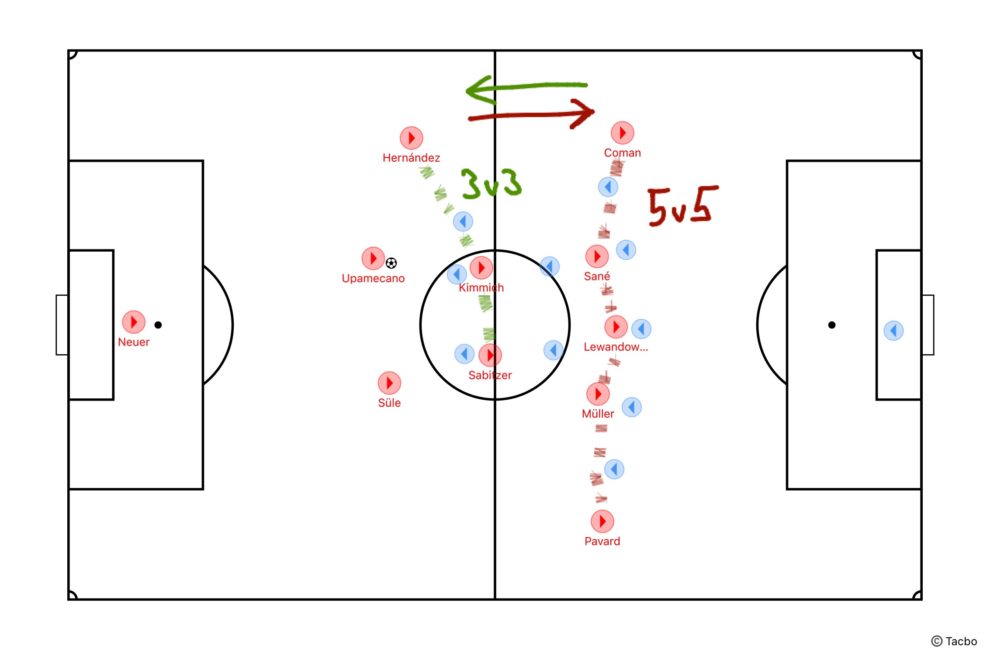
Especially implementing the last principle worked excellently in the last two games against Leverkusen and Benfica. Bayern very often managed to draw the opponent into a higher level of pressing during build-up play. While closing down the opponent’s offensive players, Bayern’s attackers always strove to keep the defensive line busy constantly and make it difficult for them to decide whether to cover and defend forward or to hold their position.
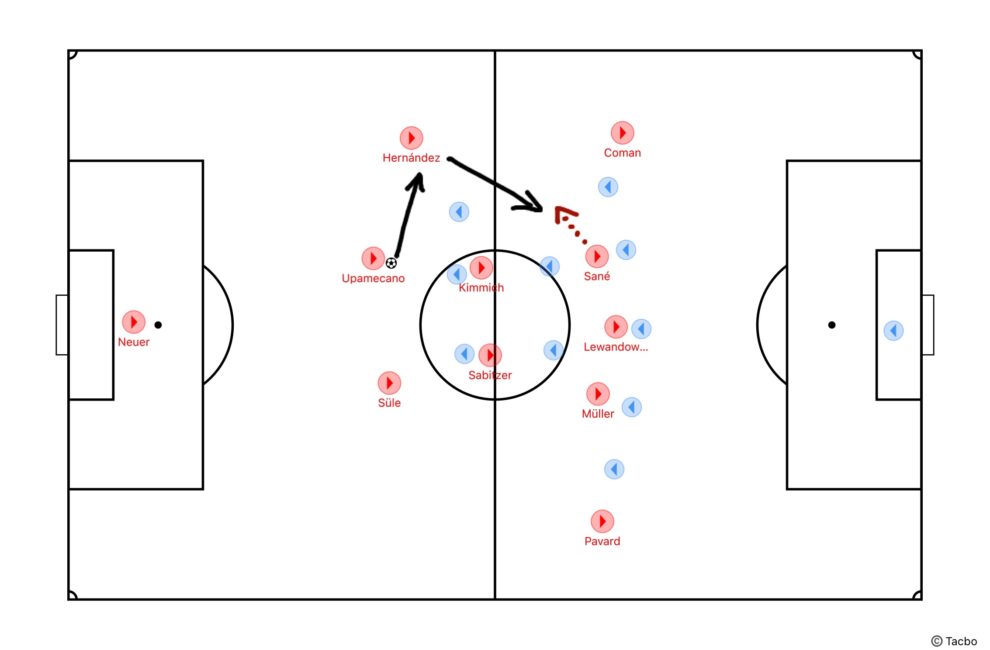
If the ball is played to Hernández in build-up, for example, Sané can opt to drop off into the half-space next to the 6s.
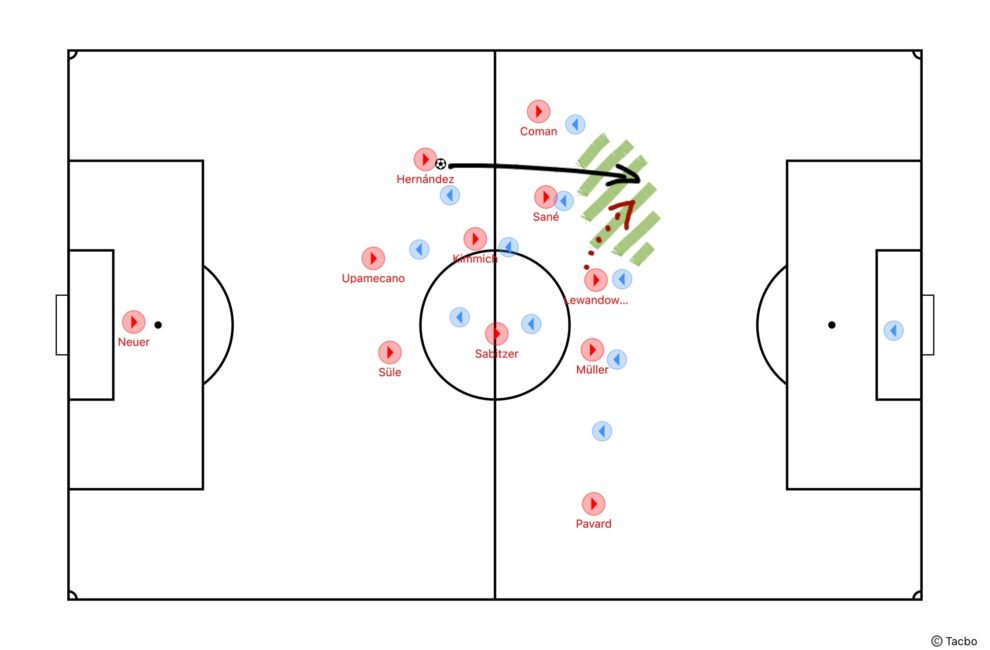
If Benfica now decide to shift with the ball, there arises a space behind the half-back for a vertical low pass or a high ball, which Lewandowski can attack in this situation. In the first half, Sané had his first big chance in a similar situation when Benfica shifted and he could run in behind.
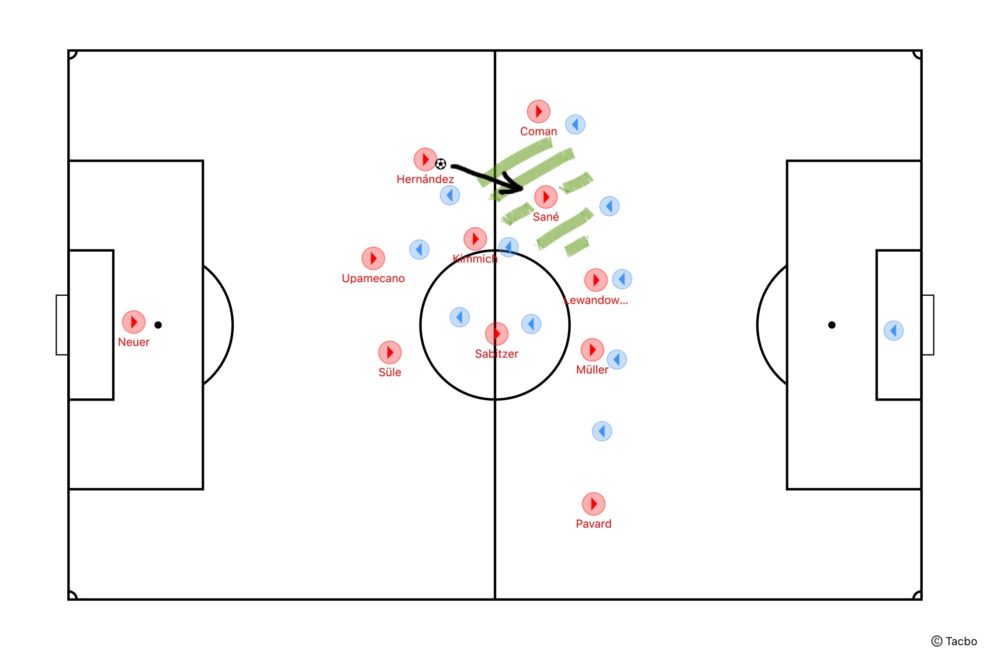
If the centre-back keeps his position, however, there is a possibility for Sané to turn around and charge downfield at speed – also dangerous. The defenders are forced to make decisions, each of which costs at least a fraction of a second. Especially as Bayern’s movements are so well coordinated, this reaction time can weigh even more heavily.
Nagelsmann takes Bayern to the next level
But it is not only the structural superiority that so often makes life easy for Bayern. It is also the class of the individual players that continues to make the difference. If Bayern were a marathon runner and the Bundesliga were the competition, they would probably even win wearing alpine hiking shoes.
Nagelsmann, however, not only gets them a pair of the best running shoes, but also gives them tips on how best to master the course.
The players’ decision-making is getting better and better. Also because Joshua Kimmich, the heart of the team, has become even better. He pulls the strings in the centre and decides when to increase the pace and when to calm the game down.
Being Joshua Kimmich: What would you do?
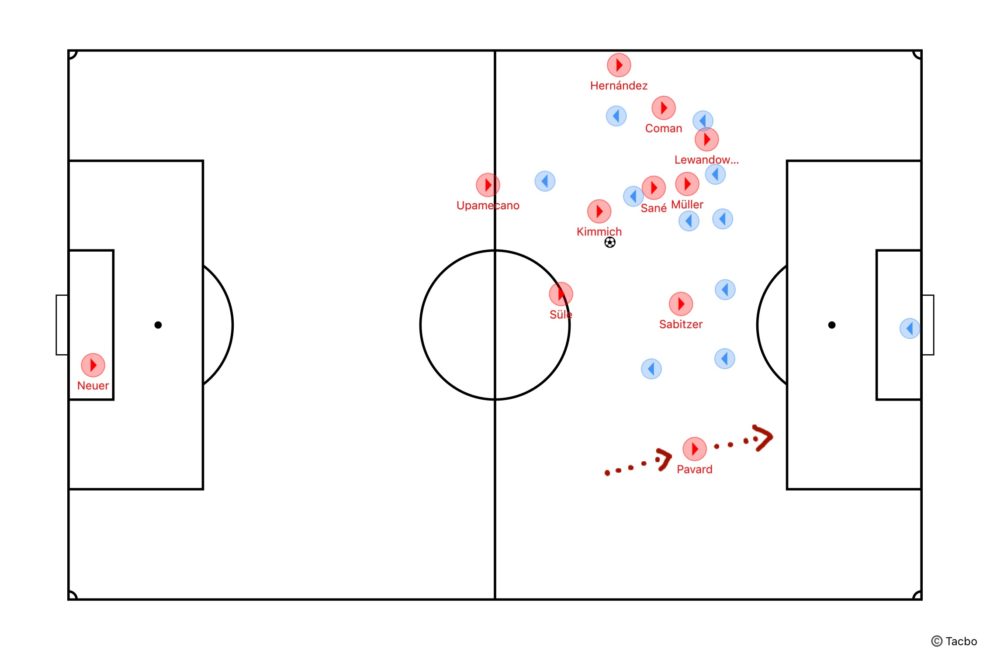
Consider this scene from the game at Benfica. It is the 19th minute. Kimmich receives the ball from one of his teammates. He has the option to push ahead in the centre but he also sees Pavard running up the pitch unmarked on the far side of the pitch. What will he do? And what would you do in his stead now?
Before we give the answer, here is another scene from the match in Lisbon. In the 20th minute, Kimmich receives the ball in the centre and has a lot of space around him. Which pass will he choose here? And which one would you choose?
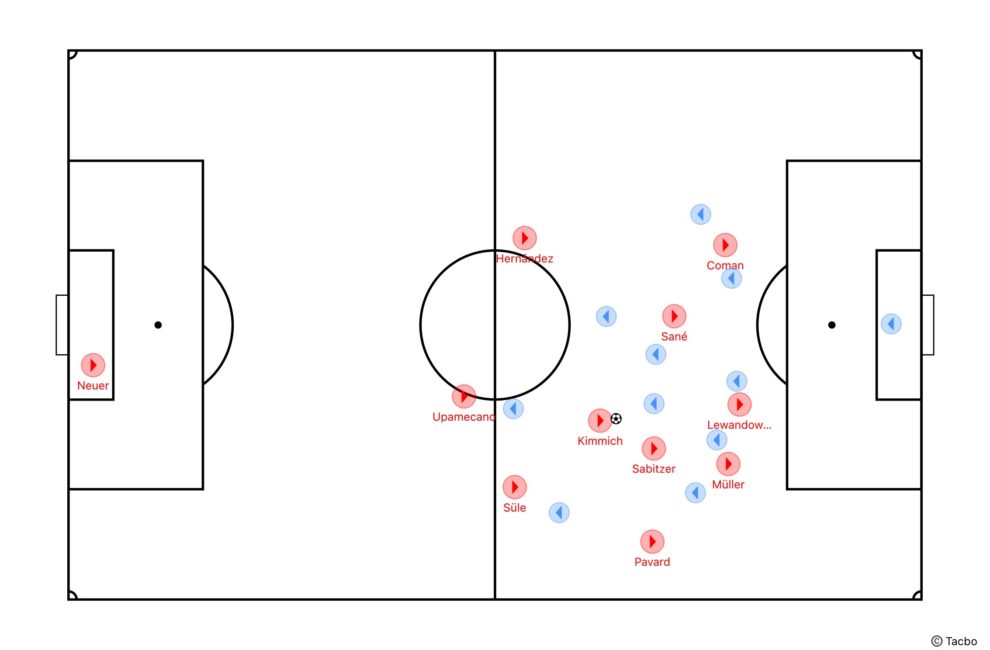
Time for answers! In the first scene, the solution seems to be quite simple. Give the ball to Pavard and make use of the large open space. But Kimmich decides against it, breaks the momentum and with the ball at his feet moves once across the pitch before he puts the ball on to Pavard with a short pass, the scene fizzles out and Bayern ultimately have to build up again from the back. But why?

Kimmich has already extensively surveyed the situation with several turns of his head before he even receives the ball. He would have to answer for himself why he decides against a switch to the far side, but his intuition is probably right. Because what would the switch have brought in this case?
Yes, Pavard would have had some open space in front of him, but since many Bayern players are still stationed so far on the left, their way into the penalty area would be too far for a high cross or a cut back to result in a promising goal opportunity. On the contrary, it could have happened that Benfica could have cleared the situation in a controlled manner and launched a dangerous counterattack because Bayern’s positioning would not have been suited for an effective gegenpressing.
On to the second scene, which is simply to underline Kimmich’s quality. Would you have expected this pass?

The situation is clear enough. Kimmich releases Sané with the tightest of through balls into a large unoccupied space. Because Bayern’s ball handling is then not good, the situation only leads to a free kick.
Playing intelligence against high pressing

But Kimmich is also one of the decisive, maybe the most decisive player against the high pressing moments mentioned before. In this situation towards the end of the first half, Benfica is well prepared and also pushes aggressively forward from the back. After Süle receives the ball from Neuer, Kimmich picks up speed quickly from a standing position and builds up distance to his opponent.
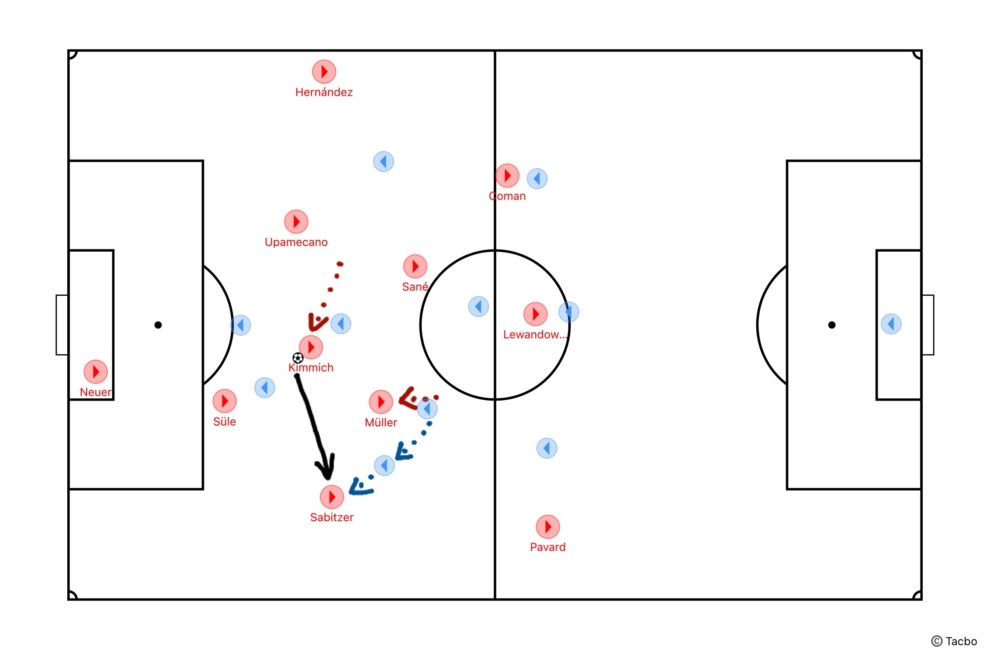
This allows him to set up Sabitzer, who is free on the right. What Bayern then do is both impressively good and bad.
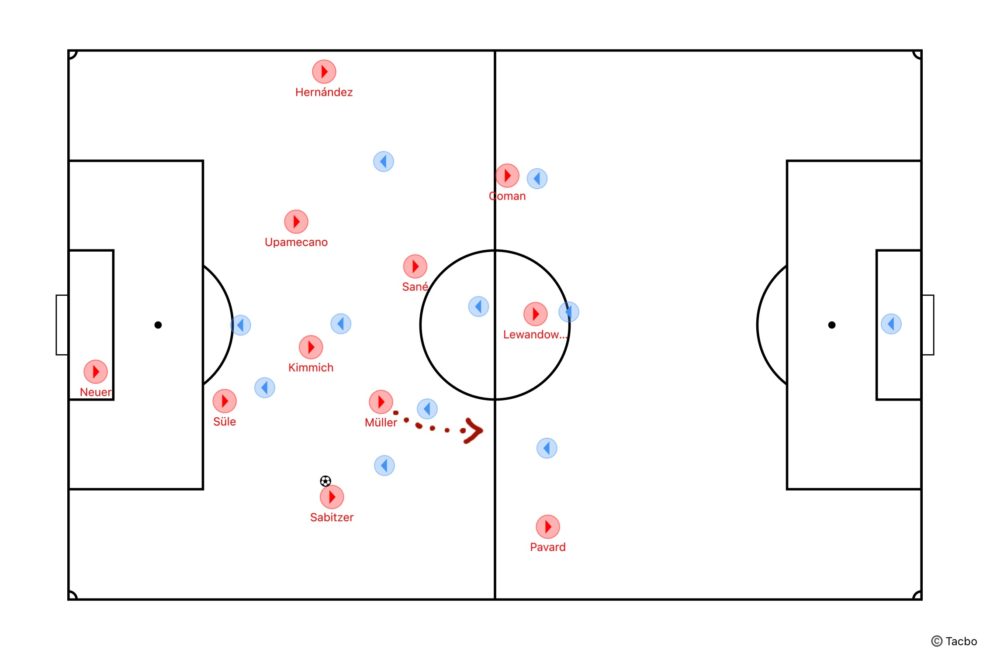
First of all, Müller reacts well. He sees Sané in the space to his right and realises that his opponent has caught on to his run towards Sabitzer. So he interrupts his initial idea and instead starts running upfield.

That, in turn, momentarily gives Sabitzer the possibility to give the ball to Sané who is completely unmarked inthe green marked space for a very brief moment. It would have been a textbook pressing break-up, as a result of which Sané could have sought a one-on-one duel or even a situation with superior numbers. But Sabitzer hesitates a tad too long, which is why Benfica can close the space again.
The Austrian can’t be blamed for that, because Benfica is wide awake in this situation and reacts quickly. Their pressing is working well and yet there was this short window of opportunity for Bayern. Because they move quickly, cleverly and extremely variably.
How will Hoffenheim go about it against Bayern?
Now it is for Hoffenheim to have a go at Bayern. The 5-0 victory over Cologne should definitely give them confidence before the match against the record champions. However, former Bayern player Sebastian Hoeneß will have to do without a number of important players. In addition to Ermin Bicakcic, Benjamin Hübner, Havard Nordtveit and Marco John, Pavel Kaderabek and Christoph Baumgartner are also out.
Hoeneß nevertheless puts on a brave face and clutches at the straws described above: “The last two games have shown that Bayern’s opponents always get a chance here and there.” Especially set-pieces and offensive transition situations are in focus here.
Hoffenheim will thus probably try to emulate the courageous pressing approach carried out by Leverkusen and Benfica rather than digging themselves in at their own penalty area.
Switching to a back three
On the other hand, Hoffenheim also have qualities with the ball that Bayern should watch out for. After Hoeneß mostly started with a back four this season, he seems to have changed his mind in the meantime having switched to a back three more regularly of late. There were problems with the back four both defensively and in ball circulation against higher pressing teams.
Centre-backs like Chris Richards or Kevin Vogt may feel more comfortable in a three-man backline because they have different passing angles into midfield and better support at their side. However, Florian Grillitsch was arguably the key player in the surprising 5-0 victory.
Grillitsch as a key player
The Austrian, who is actually a midfielder by trade, has given a number of impressive performances playing in the mod position of a five-man back line in recent months. This is above all because he has more time to consider his next actions there. Only rarely do opposing attackers manage to press through to him. So he can observe the game with time on his hands and distribute the balls like a quarterback.
His long diagonal balls are particularly dangerous. Against Bayern, he will probably find himself in pressure situations more often. The Bayern team usually maintains a very compact shape in gegenpressing situations. If Grillitsch finds a little space to play one of his diagonal balls, this could put the defence of the record champions under pressure.
This is not least because Hoffenheim is quite apt at handling the ball. Consider this situation in which they scored the opening goal against Cologne:
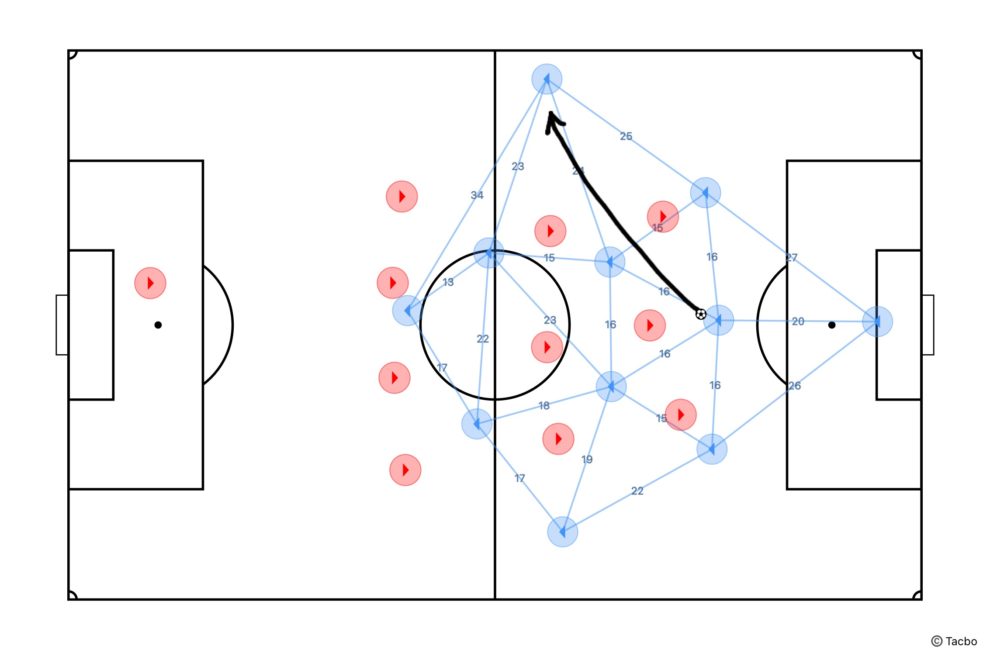
In the seconds leading up to the goal, Hoffenheim almost perfectly manage to exploit the spaces in the gaps of Cologne’s compact pressing formation. Grillitsch in the centre plays the ball out to the right wing and ultimately Bebou has a one-on-one showdown with Horn. Bayern will not give Hoffenheim as much time on the ball as Cologne did despite their rather high positioning, but if they do, this situation shows what could be in store for them.
Which way does the Hoeneß balance turn?
At the moment the straws that opponents of FC Bayern are clutching at are few and far between. But they do exist. Hoffenheim will have taken a close look at the little more than ten minutes in FC Bayern’s second half on Wednesday night.
Was Benfica dominant or clearly better than Bayern during that phase? Certainly not. But with set-pieces and cleverly played transition situations, the use of which Hoeneß has already proclaimed, there might be something in it against a Bayern team that can only beat itself at the moment.
After all, Hoeneß can look back on a balanced record after two bouts against the record champions. The furious 4-1 victory over a tired FC Bayern was followed by a 1-4 defeat in the Rückrunde. So now he has the chance to turn it around – against all odds.



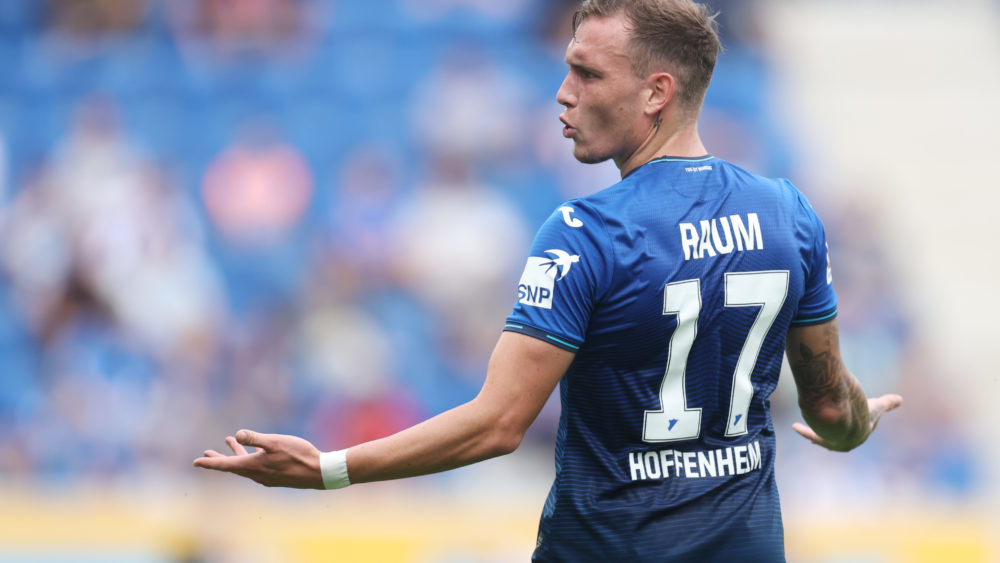








Great analysis! Just a couple of thoughts. What a tremendous joy it is to watch Bayern play the Nagelsmann system. I thought that it might be like this. Combining JN’s tactics with Bayern’s talent and intelligence. JN is also an excellent player manager who has the respect of the players, not always that easy to do.
It is so much fun to watch the games!